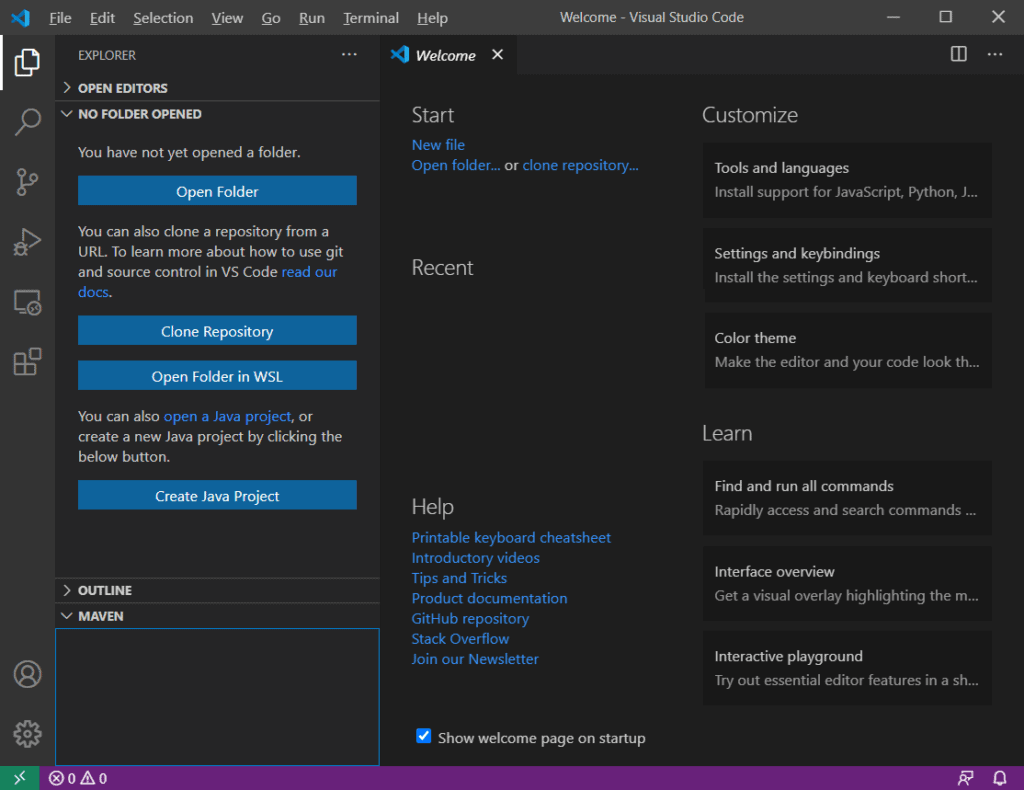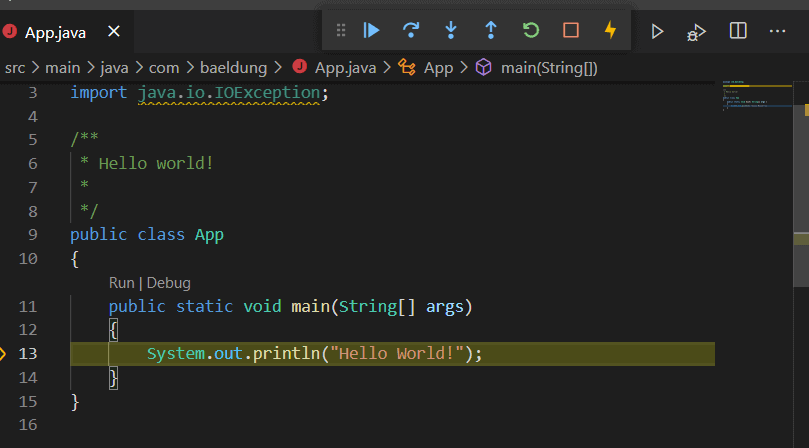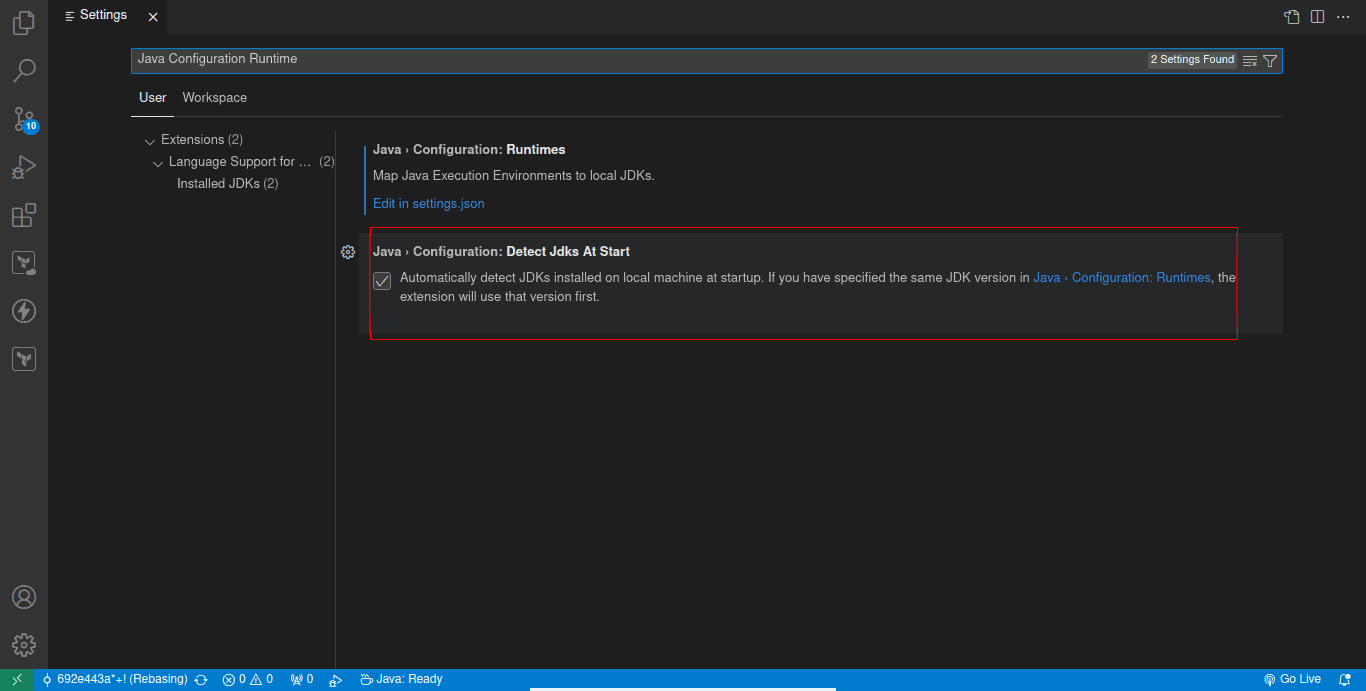1. 概述
本文将介绍如何在 Visual Studio Code(VS Code) 中配置 Java 开发环境,并使用其基本功能。接着我们会看看它对 Maven 和 Gradle 的支持情况,最后总结它的优势与不足。
2. 配置 VS Code 以支持 Java
微软近年来大幅提升了 VS Code 对 Java 的支持体验。**推荐直接下载 Coding Pack for Java**,这是一组核心扩展的打包安装包(可以理解为 Eclipse 的 JDT 工具链)。
即使你还没安装任何东西,这个可执行包也会自动检测缺失的软件并帮你安装:
✅ Visual Studio Code
✅ Java Development Kit (JDK)
✅ Java Extension Pack(包含以下扩展):
- Language Support for Java™ by Red Hat:支持导航、编写、重构和阅读 Java 文件
- Debugger for Java by Microsoft:启动/附加调试、断点、表达式求值、调用栈查看
- Maven for Java by Microsoft:基于 Archetype 创建项目、运行 Maven 目标
- Java Test Runner by Microsoft:运行 JUnit、TestNG 测试
- Project Manager for Java by Microsoft:展示项目结构、创建新项目、导出 JAR 包
- Visual Studio IntelliCode by Microsoft:提供更智能的自动补全建议
如果你已经安装了 VS Code,只需从侧边栏的 Extensions(扩展)中安装 Java Extension Pack 即可。
安装完成后,你会在左侧看到“Create Java Project”按钮和 Maven 视图:
也可以通过菜单 View > Command Palette 查看所有 Java 功能:
接下来我们来详细了解这些扩展提供的功能。
3. 使用基础 Java 项目
3.1 创建或打开 Java 项目
要创建新的 Java 项目,可以在命令面板(Command Palette)中找到 Java: Create Java Project 命令,在弹出菜单中选择项目类型:
- ✅ No build tools:创建一个空白项目,含
src和lib目录 - ✅ Maven:可以选择一个 archetype 来生成项目(详见后文)
- ⚠️ Spring Boot, Quarkus, MicroProfile:需要先安装对应扩展才能创建项目
如果要打开已有项目,VS Code 会在右下角弹出提示框,询问是否导入为 Java 项目。如果错过了,只需打开任意 .java 文件即可重新触发。
3.2 运行和调试项目
运行项目快捷键如下:
F5:调试模式运行Ctrl + F5:普通运行
还可以直接点击 main 方法或单元测试上方的 Run | Debug 快捷按钮:
调试时顶部会出现调试工具栏,可以控制程序继续执行、停止、重启等操作。底部的 Terminal(终端)会显示输出日志。
3.3 管理 Java 包和导入
⚠️ VS Code 没有专门的功能用于创建类或包,这是个让人踩坑的地方。
正确的做法是:
- 先新建一个
.java文件; - 在文件顶部声明所需的包名;
- 此时会报错:“The declared package does not match the expected package”;
- 将鼠标悬停在错误上,点击 Quick Fix,它会自动帮你创建完整的目录结构。
不过包管理和导入功能还是挺标准的:
- 按
Ctrl + Space可以快速导入已有类; - Quick Fix 弹窗可以帮助你添加缺失的 import 或移除未使用的 import。
3.4 代码导航和自动补全
几个关键快捷键必须掌握:
Ctrl + P:打开文件Ctrl + T:跳转到类或接口Ctrl + Click:跳转到方法定义或类实现- 侧边栏中的 Outline(大纲)视图:适合浏览大型文件结构
自动补全功能也很强大:
- 输入
Ctrl + Space显示可用选项; - 支持接口实现、类方法/属性列表展示,甚至包括 Javadoc 注释;
- 在
while,for,if,switch,try等语句后输入Ctrl + Space,可以生成完整代码片段。
❌ 不过目前还不能自动生成方法参数的 Javadoc。
3.5 编译错误和警告
编译错误会以下划线标出,未使用的变量则会变灰。
可以通过 View > Problems 查看所有错误和警告,并且大多数问题都有 Quick Fix 提示。
3.6 配置 Java 版本
Java Extension Pack 从 1.2.0 起默认使用嵌入的 JRE 17 启动 Java Language Server,提供语法高亮、补全等功能。但如果你要编译项目,还需要配置 JDK。
手动指定 JDK 路径
点击左侧面板最后一个图标(Manage),进入 Settings 页面,搜索 “Java Configuration Runtime”,然后点击 “Edit in settings.json”。
修改如下配置项:
"java.jdt.ls.java.home": "/usr/lib/jvm/java-21-openjdk"
⚠️ 注意:原来的 java.home 已被弃用,推荐使用 java.jdt.ls.java.home。
同时也要配置 java.configuration.runtimes 属性,以便支持不同版本的 JDK 编译:
"java.configuration.runtimes": [
{
"name": "JavaSE-1.8",
"path": "/usr/lib/jvm/java-8-openjdk/",
"default": true
},
{
"name": "JavaSE-17",
"path": "/usr/lib/jvm/java-17-openjdk/",
"default": true
}
]
📌 注意事项:
- 名称需遵循 JavaSE 格式;
- 路径必须是本机实际 JDK 安装路径。
自动探测本地 JDK(推荐)
你也可以让 Java Extension Pack 自动探测本地已安装的 JDK,无需手动配置路径:
只需勾选相关选项即可启用自动检测功能。
4. Maven 和 Gradle 集成
4.1 Maven 支持
若要创建 Maven 项目,可在命令面板中选择 Maven archetype。选择后,系统会在交互式终端中引导你完成配置,而不是像传统 IDE 那样有图形向导。
首次打开项目时,VS Code 会弹出导入提示,随后开始 Maven 配置过程。默认使用系统 PATH 中的全局 Maven 客户端,但如果项目中配置了 Maven Wrapper,则会弹窗让你选择是否使用 wrapper。
然后你可以在 Maven 侧边栏看到可用的插件和目标:
如果没看到,可以从以下位置排查问题:
View > Problems:检查pom.xml错误或 JDK 兼容性问题View > Output:选择底部右侧的 Maven For Java 查看 Maven 客户端或 wrapper 的错误信息
4.2 Gradle 支持
要使用 Gradle,需先安装 Gradle Extension Pack 扩展。该扩展只支持配置了 Gradle Wrapper 的项目。
打开 Gradle 项目后,底部状态栏会显示下载和安装进度。点击状态栏可查看是否有错误发生。也可通过 View > Output 并选择 Gradle Tasks 查看详细输出。
成功加载后,左侧会出现 Gradle 大象图标,点击后可以看到任务管理面板:
如果没有显示大象图标,请检查项目是否位于子目录中,如果是,需启用 gradle.nestedProjects 设置才能识别。
5. 优势与不足
VS Code 是一款轻量级编辑器,相比专业 Java IDE(如 IntelliJ IDEA、Eclipse)确实存在一些短板:
❌ 缺少图形化向导
❌ Maven/Gradle 集成不够友好
❌ 没有内置包管理器和依赖管理工具
⚠️ VS Code 并非专为 Java 设计,这一点从很多细节上都能感受到,特别是对习惯了传统 Java IDE 的开发者来说。
✅ 但其核心功能如语法检查、自动补全都非常完善,得益于 Eclipse JDT language server 的加持。
✅ 此外,VS Code 的优点也很明显:
- 启动速度快
- 内存占用低
- 用户体验好(插件生态丰富)
6. 总结
本文介绍了如何在 VS Code 中配置 Java 环境、使用其主要功能,并分析了它的优缺点。
✅ 如果你已经熟悉 VS Code,它是一个不错的入门 Java 编辑器;
❌ 但如果你已经是 IntelliJ 或 Eclipse 的资深用户,可能会觉得它缺少太多“舒适区”功能,反而不太适应。





